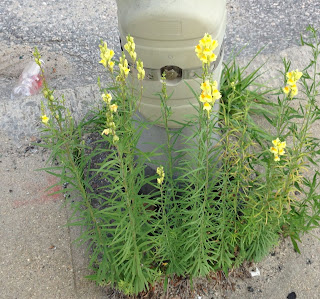I walk through that green space every day. I rejoice in it.
I love my friend Oma’s comment recently: “Here in England it's not so important
to drive as over there [in the USA]. In your neighbourhood it looks
similar. As long as you can get to the shops, you can walk along the sidewalks
and look at the flowers or the weeds.”
Notice what she said: “the flowers or the weeds.”
She and I feel the same way: weeds are lovely too. She sent
me a lovely book about weeds a while back, and it was after my own heart.
Here are some of my own photos of weeds / wildflowers in the
neighborhood. They’re not as good as they might be, but oh well, I’m a terrible
photographer, who cares?:
CHICORY (Cichorium intybus). Beautiful
blue/purple flowers. This is a picture of a lovely stand of them very near the
Point Street Bridge. The roots are roasted and ground and mixed with coffee; I’ve
had coffee with chicory, and it’s delicious.
BUTTER
AND EGGS (Linaria vulgaris). A
beautiful roadside wildflower. Not useful for anything that I know of.
Also called “toadflax.” I like the name “butter and eggs” better
MILKWEED (Asclepias sp.). I mistakenly told a
coworker recently that this was “Joe Pye Weed,” which is horribly wrong. The
flowers are very fragrant, and the plants are attractive, and the seeds are big
cloudy masses of fluff.
RABBIT’S
FOOT CLOVER (Trifolium arvense).
I only identified this one a few weeks ago. It’s obviously a clover, but
fuzzier, and very cute. This one was huge until it was cut down by the city,
but it began to come back within days. You can’t kill clover.
BIRDSFOOT
TREFOIL (Lotus corniculatus). Obviously a legume, with beautiful yellow pea-like blossoms. The
whole field was golden with these, until they were cut down. They too came back
within days.
JAPANESE
KNOTWEED (Fallopia japonica). A
terrible invasive species from Asia. But it has lovely foliage and nice flowers.
DEADLY
NIGHTSHADE (Atropa belladonna). A
relative of the tomato. Look at this pretty little lady, with pretty purple
blossoms! But she’s terribly poisonous. Notice the cute little green
mini-tomato berries; they’ll be a delicious-looking red later in the season.
Just don’t eat them, okay?
QUEEN
ANNE’S LACE (Daucus carota). The
wild carrot. This is a sweet little flower that also grew very healthily where
I was born, back in southwest Washington. This is a very small specimen, but
nice; I’m always glad to see it.
These are all just as beautiful as any garden flowers. More
so, really, because they don’t rely on gardeners to take care of them.
They take care of themselves.










No comments:
Post a Comment